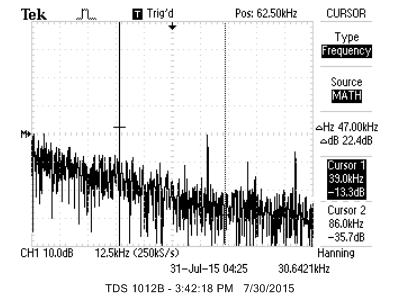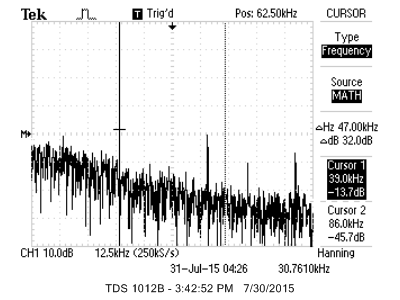rand() function. The images below show hstograms of 15-bit values, binned into 240 bins. The left image uses the full algorithm, the right image is just the shifted sum of the two ADC readings. Both histograms are fairly flat. With about 24,000 points in 240 bins, there is an average of 100/bin, so the RMS noise on the histogram should be about 10%. (project ZIP)
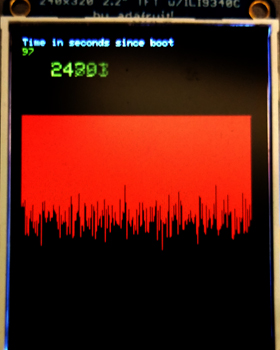
rand(), does the filtering, and sets to the 10-bit PWM sample rate. OC3 is used and is connected to pin 21 using the RPB10 in PPS. There are three threads, a keypad thread, a system timer thread, and the seed generator thread.The keypad thread does most of the work:
-- Spawns a seed thread to get a new seed, and resets the histogram, when the # key is pressed
-- Turns off a PWM random noise generator when 0 key is pressed
-- Turns on a PWM random noise generator and plots a histogram of noise when 1 key is pressed
-- Sets a filter coefficient when keys 1 to 7 are pressed. Frequencies vary from 0.005 to 0.5 of the Nyquist frequency.
The code uses 2.14 fixed point for the digital lowpass filter. (project ZIP).
The left image below shows the power spectrum when the digital fiter is set to 1KHz and filtered through an analog RC lowpass with a cutoff frequency of 10,000 radians/sec. Spectrum is flat up to about 1 KHz, then drops 10 or 12 db over the next factor of two in frequency, correspoinding to a 2-pole filter (one digital, one analog). Higher frequency spikes are caused by aliasing of the PWM carrier frequency.
The right image below removes the analog filter and sets the digital filter to 9.8 KHz. You can see a clear dropoff at about 9 or 10 KHz, bottoming out at 21 KHz, then increasing again with a large spike at the location of Cursor-1, which is at 39 KHz, the PWM carrier frequency. My guess is that the secondary hump and all the other spikes are aliased data because of the energy at the PWM carrier frequency. Since human hearing stops around 20 KHz, the high frequency junk is inaudible. Of course outputing the data to a real DAC would remove much of the high frequency, aliased, energy.
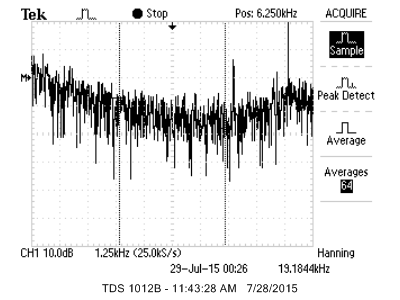
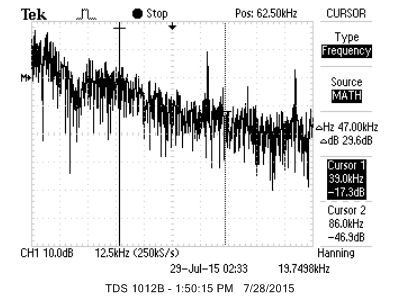
rand(). The four statements makeing one shift operation take 10 cycles to execute, compared to 35 cycles for rand(). As in the last example, bandlimited white noise is generated on a PWM channel using a new random seed every time you ask for a new seed. There is an ISR running at 39062 Hz (40 MHz/1024) which generates the white noise using the LFSR, sets the number of LFSR shifts/sample, and sets to the 10-bit PWM sample rate. There are three threads, a keypad thread, a system timer thread, and the seed generator thread. (project ZIP)The keypad thread does most of the work:
-- Spawns a seed thread to get a new seed, and resets the histogram, when the # key is pressed
-- Turns off a PWM random noise generator when 0 key is pressed
-- Turns on a PWM random noise generator and plots a histogram of noise when 1 key is pressed
-- Sets the number of times the LFSR is shifted for each sample when keys 1 to 4 are pressed. More shifts/sample decorrelates the LFSR resulting in higher bandwidth noise. One shift/sample results in a bandwidth of approximately (sample frequency)/7. Two shifts/sample has a bandwidth of about (sample frequency)/3, and four shifts/sample a bandwidth of about (sample frequency)/2, as much bandwidth as it can have. The three images show 1-, 2-, and 4-shift spectra, with no digital or analog filtering. The cursor is set at the PWM frequency. You can see that the spectrum gets flatter (but lower amplitude) with more shifts.

